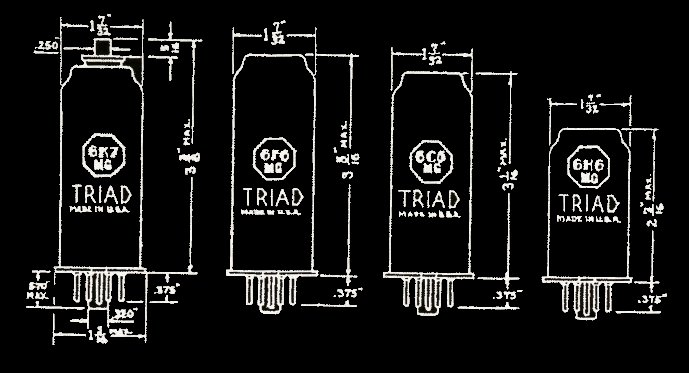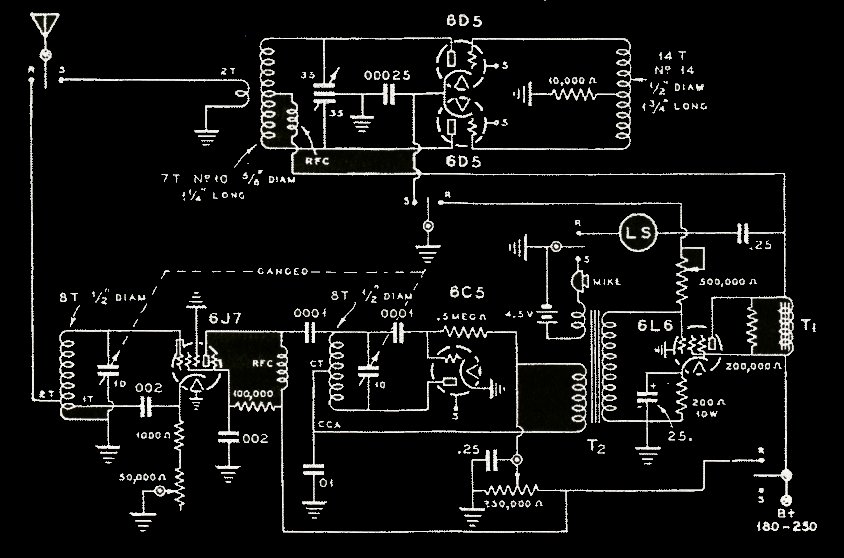TRIAD MANUFACTURING CO., INC. - PAWTUCKET, R. I. - U.S.A.
Triad Manufacturing Company is pleased to announce a new line of tubes known as the MG series. Consistent with its established reputation for progress and individuality, Triad has produced a non-breakable, fully shielded, metal tube in which a newly developed glass is used for maintaining the vacuum. By this method the same vast experience accumulated in several decades of lamp and radio tube manufacture, is not suddenly upset and consequently, the Triad series MG will have the same long and serviceable life that has characterized properly made glass sealed tubes in the past.
Certain highly publicized so-called metal tubes now available, consist of a series of glass to metal seals in addition to several metal to metal welds. By this construction, the overall height of certain tubes is reduced but it is the contention of the Triad Engineers that the series MG described herein offers the same technical advantages, a greater sales appeal, and less inherent risk to the manufacturer adopting these types.
It should be further noted, that the Triad series MG is not a line of tubes for some indefinite date in the future. Equipment has been installed during the past several months to produce 10,000 of these tubes per day for immediate delivery to manufacturers adopting the Triad line. This new line of tubes has the further advantage of being designed such that it is fully interchangeable with the existing metal tubes. The new standard octal bases are used throughout and base wiring is in accordance with the standards of the Industry.
As a further advantage, the manufacturer is offered four additional types for AC-DC uses. These types have the same characteristics as the corresponding glass types, but they have been re-designed to conform with the metal tube series.
The rating and basing arrangements of the MG series will be found elsewhere in this bulletin. A brief description of the MG types may be of help in becoming familiar with the new type numbers.
5Z4 The
5Z4 is a cathode type, full wave rectifier having low voltage drop for general use. It has approximately half the voltage drop of the corresponding glass type
80. Heater and cathode are tied together internally.
6A8 This tube is essentially the same as the type
6A7, except for the additional pin tied to the external metal shell.
6C5 This tube is a triode detector-amplifier very similar in characteristics to the familiar
6C6 when the latter is connected as a triode.
6D5 The
6D5 is a power amplifier triode. Its characteristics are quite similar to the type
42 when the latter is connected as a triode.
6F5 This high-mu triode is practically the same, so far as electrical characteristics are concerned, as the triode section of the familiar type 75. The grid connection is brought out through the top cap.
6F6 The metal type
6F6 is electrically similar in all respects to the type
42 when employed as a pentode power amplifier.
6H6 This double diode is designed to provide for AVC and diode detection. It is similar in every respect to the double diode section found on multipurpose glass tubes except that both cathodes are brought out separately.
6J7 This hi-mu pentode detector amplifier is similar electrically to the type
77.
6K7 The
6K7 is a triple grid variable mu amplifier similar to the well-known type 78.
25Z5 MG This special type is provided to fill the need of a rectifier for AC-DC sets and is similar electrically to the type
25Z5.
43 MG This type has characteristics identical to the 43 and provides a power output tube to complete the AC-DC line.
50A2 MG This is a ballast tube in a metal shell with a tap to supply two #40 pilot lights in series.
50B2 MG The
50B2 MG is designed for the same service as the
50A2 MG but tapped to supply a single #40 pilot lamp. Both ballast tubes have an overall voltage drop of 50 volts and are employed in transformerless receivers for AC-DC voltage. For example a
25Z5 MG rectifier, a
43 MG power output tube, a
6K7 R.F. amplifier and a
6J7 detector comprise a typical compliment [sic] for ballast tube operation.
This listing of metal shielded tubes should not be considered complete, but simply the list of types which are now in production. Considerable experimental work is being done on various types of metal shielded tubes at Triad. When this experimental work indicates that additions or changes should be made to our production types, improvements will be incorporated.
With the innovation of the new series MG tubes, it is assured that most of the basic and essential experience gained from glass tube processing will be incorporated in the making of the new metal glass tubes. These facts cannot be over look [sic] so readily, in view of the widespread use and acceptance of the glass tubes. Combining this knowledge with the new principle of metal tube design, a most permanent and useful series of radio tubes has been developed.
 About the same time, Arcturus put out its "Coronet" series (covered in TC, August 2016 and April 2017), a similar glass-in-metal line with adapters to "modernize" existing radios. (The radio manufacturers don't seem to have bought this series.)
About the same time, Arcturus put out its "Coronet" series (covered in TC, August 2016 and April 2017), a similar glass-in-metal line with adapters to "modernize" existing radios. (The radio manufacturers don't seem to have bought this series.)
Triad added a few MG types, like the 6N5MG and 6Q7MG. A few radios were all-MG. The Silvertone models 1909, 1912, and 1962 sported a 6A8MG, 6K7MG, 6Q7MG, 6C5MG, push-pull 6F6MGs, and a 5Z4MG. Hytron also sold some MGs like the 6J7MG and 6K7MG, possibly made by Triad. So did KenRad (a 6A8) and National Union (a 6Q7MG)
However, when Triad brought out its "Triadyne" group of output tubes (dual triodes with a cathode follower vigorously driving the output side) in 1935-37, they were glass types. These were the 6B5, 6AB6, 6AC5G, 6AC6, 25B5 and 26N6G. (There may have been a few MG versions of the 6B5 and 6N6G.) In any event, their June 1937 product list shows nothing "MG" or metal in any other form.
In regard to the ill-fated 6D5, RCA designed it and did some pilot production. However, a manual scan of the 1938 Mallory-Yaxley Radio Servicing Encyclopedia shows nothing using the tube. Use of the "Radio Finder" search feature of John Okolowicz' www.grillecloth.com automatically searches it and two other data bases, and gives the same answer. However, there was one known ap plication. The 1937 edition of the Jones Radio Handbook (Frank C. Jones, editor) shows a "metal tube 5-meter transmitter-receiver" in which the transmitter is push-pull 6D5s! "The 6D5s are similar to glass type 45s."


